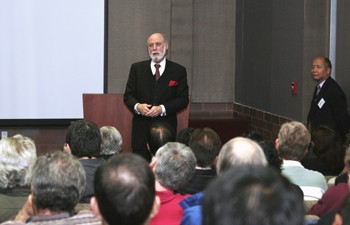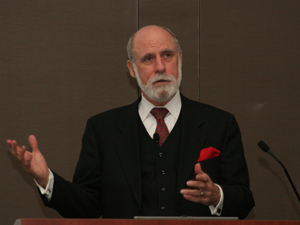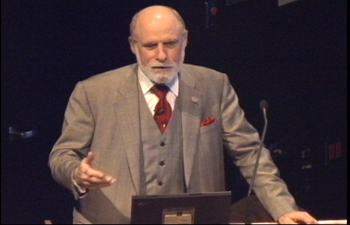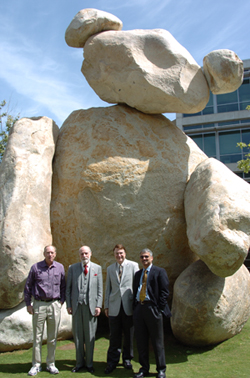Calit2 Audiences in Irvine and San Diego Welcome Google's Internet 'Evangelist'
Irvine and San Diego, CA, April 23, 2007 -- Internet pioneer Vinton Cerf -- who sits on Calit2's Advisory Board -- made a two-stop visit to the institute last week. As Google's Chief Internet Evangelist, he gave presentations to standing-room-only audiences at the UC Irvine and UC San Diego divisions of Calit2, attracting attendees from across both campuses and from among their industry partners.
|
Cerf told the overflow crowd at Calit2@UCI [see video link at right] on Wednesday, April 18, that when he and colleague Robert Kahn were working on the design of the Internet in 1973, they decided whatever blueprint they came up with had to work on new telecommunications systems that would not be invented for years. "We didn't know what new telecommunication technologies would be invented and we wanted the Internet to work on them even though we didn't know what they were," he told the group.
The forward-thinking pair decided to build the basic design criterion for the protocol independent of the underlying physical transmission media. "So when optical fiber came along, and satellite links became available, or Wi-Fi or ATM or frame-relay, all those things were made to carry Internet packets," he said.
The TCP/IP protocols that Cerf and Kahn designed utilize information packets that don't know or care what kind of information they're carrying. "All the packets know is that they're carrying bits," Cerf explained. "That could be email or a piece of video or audio or a Web page. This has probably been the single most fundamental design decision that we made, because it stimulates unlimited innovation." He added that the openness and freedom to explore the network "is the most important property we can preserve on the Internet as the future unfolds."
|
Cerf pointed out that although the Internet emerged in the United States, it has grown into a global communication medium. Ten years ago, most users were in North America. Today, North America accounts for 232 million users, while Asia and Europe have more (389 million and 312 million, respectively) - statistics that will impact the content of the network and the languages that are used to interface to it.
He also addressed unfolding social and economic effects on the network. For example, consumers of content are now becoming producers - think Wikipedia, YouTube, Facebook and MySpace. This has led to the Internet becoming a completely democratic system, both for access and production. "Users are becoming the center of the universe," Cerf stated. "They are in charge. They are in control."
|
The next day, Cerf addressed another packed house, this time in the Calit2 Auditorium of Atkinson Hall on the UC San Diego campus. His talk on "Internet Research Challenges" was webcast live, and archived for later on-demand viewing [see box at right].
He noted that in the past ten years, the number of servers hooked up to the Internet has exploded from 22 million to 433 million. But, he pointed out, "in June of 2006, the statistics showed 439 million hosts, so that is the first time that we have seen this particular data from the Internet Software Corporation trend down rather than up, and we're just not sure why." One possibility, he mentioned: more servers may be hidden behind firewalls.
During the past decade, meanwhile, the number of Internet users has also exploded, from 50 million to over one billion. And with "increasing numbers of wireless phones and other devices being Internet-enabled," said Cerf, "that means that for many people in the world, their first introduction to the Internet will be through mobiles rather than through desktops and laptops."
|
Cerf recalled being a graduate student at UCLA when the first packet switch was installed as part of ARPANET. "That machine is now in the Computer History Museum, and of course some people think I should be there with it," he joked.
During his visit to San Diego, UCSD division director Ramesh Rao briefed him on new developments, including the creation of Calit2's new Center of Interdisciplinary Science for Art, Architecture and Archaeology (CISA3), which applies multispectral imaging and other digital technologies to learn more about cultural heritage. UCSD archaeology professor Tom Levy also briefed Cerf on the institute's plans for a Digital Archaeological Atlas of the Holy Land. The Google executive has taken a special interest in efforts to spread the benefits of the Internet to new fields, and Cerf spoke earlier this month at the summit of the Digital Humanities Centers organized by the National Endowment for the Humanities (NEH).
Prior to his talk in Atkinson Hall, Cerf also addressed nearly 500 private-sector attendees at a meeting of the San Diego Venture Group. Joining him on stage for Q&A and a discussion about the future of the Internet were Calit2 director Larry Smarr, and former Jacobs School of Engineering dean Bob Conn, who is now managing director at Enterprise Partners Venture Capital and also a member of the Calit2 Advisory Board.
After helping to develop TCP/IP packet switching networks and the ARPANET, Cerf developed (at MCI) the first commercial email service to be connected to the Internet. He joined Google in September of 2005 as its Chief Internet Evangelist. Cerf received the U.S. National Medal of Technology in 1997, and the Presidential Medal of Freedom in 2005, for his work that "enabled the digital revolution and transformed global commerce, communication, and entertainment."




